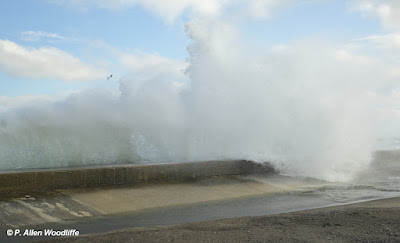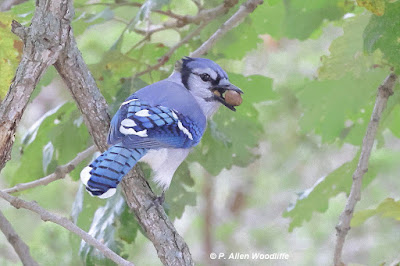With the seasonal ups and downs, it must have some of the butterflies confused. I don't recall ever seeing Black Swallowtail caterpillars so abundant so late in the season, but just in the last couple of days before the temperature took a significant drop (Oct 25), we came across three caterpillars out feeding on some carrots that are still in the garden.
They were all fairly well developed, so if they hurried, they may have been able to complete this stage and form a pupa for the over winter period.Good luck to them!
The Keith McLean Conservation Lands have been an ongoing place of interest. One never knows what to expect, except that it seems to attract Nelson's Sparrows fairly regularly in October. I have been there a couple of times, and have seen them both times, but they are often elusive and do not cooperate for the camera. Some folks have gotten some quite good photos during their visits, but so far I have only gotten one poor record shot, as shown next.
This is one of my best shots, from a couple of years ago. There is still time for more attempts this year, but depending on the weather, opportunities will be dwindling.White-crowned Sparrows were a little more accommodating.
There have been lots of Green-winged Teal, and other ducks. This next photo shows some of these teal, and in their midst are some Dunlin and a single Killdeer. Dunlin have been quite abundant, with sometimes more than 100 noted.
 |
| Dunlin in flight |
One or two Great Blue Herons sometimes provide a photo op.
I missed out on the Cattle Egret that was seen on one occasion, but it may still be around somewhere in Chatham-Kent. I will keep looking!
At Rondeau, there is an abundance of berries on some but not all, of the Red Cedars, especially in the campground, and if one can find the right tree that the birds have also found, it can be rewarding. Light is important, but the birds are not considering that in their quest for nourishment.
Robins, of course....
...and young of the year. I kept an eye open for the very rare Bohemian Waxwing, but did not see any. No one else has reported them lately either, but it is not impossible.
Pileated Woodpeckers are year-round residents of Rondeau, but not commonly seen. Decent photo ops are always fun.
It wasn't all that long ago that the forest looked typically like this, still fairly green and luxuriant.
 |
| October 19 |
 |
| Oct 23 |
 |
| October 27 |
There is more and more sky showing, but by moving a bit and using a longer focal lens, I can get the colourful tunnel look.
Elsewhere not far from home, I have been up along the Lake St. Clair wetlands. There have been a few of the usual things of interest, including a few Midland Painted Turtles soaking up some late season sunshine.
Duck diversity is increasing, such as these three Northern Pintail in amongst Canada Geese and other ducks.
A highlight was to see this single Snow Goose, not all that surprising given the time of year. More are likely soon, along with things like Ross's Goose and Greater White-fronted Goose. I will be on the lookout for them soon!
If you would like to subscribe, or unsubscribe, to Nature Nuggets, send an email to: prairietramper@gmail.com



































































